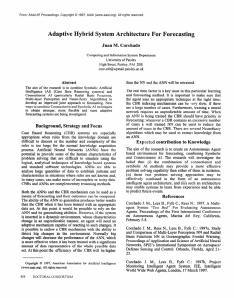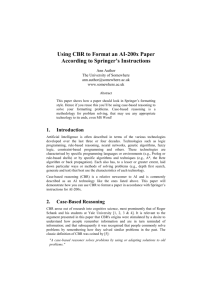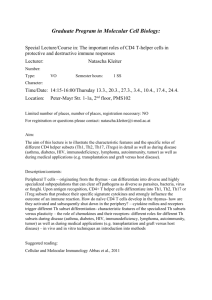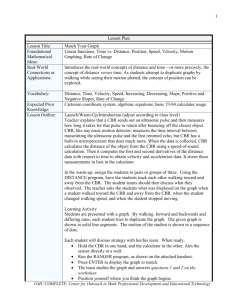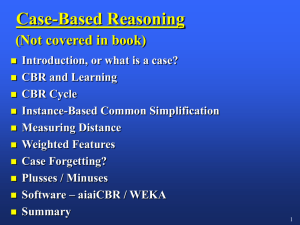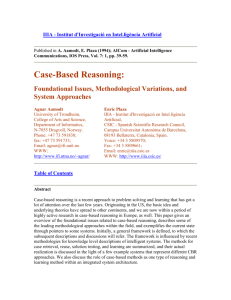A CBR system to assist the internal control process of a firm
advertisement
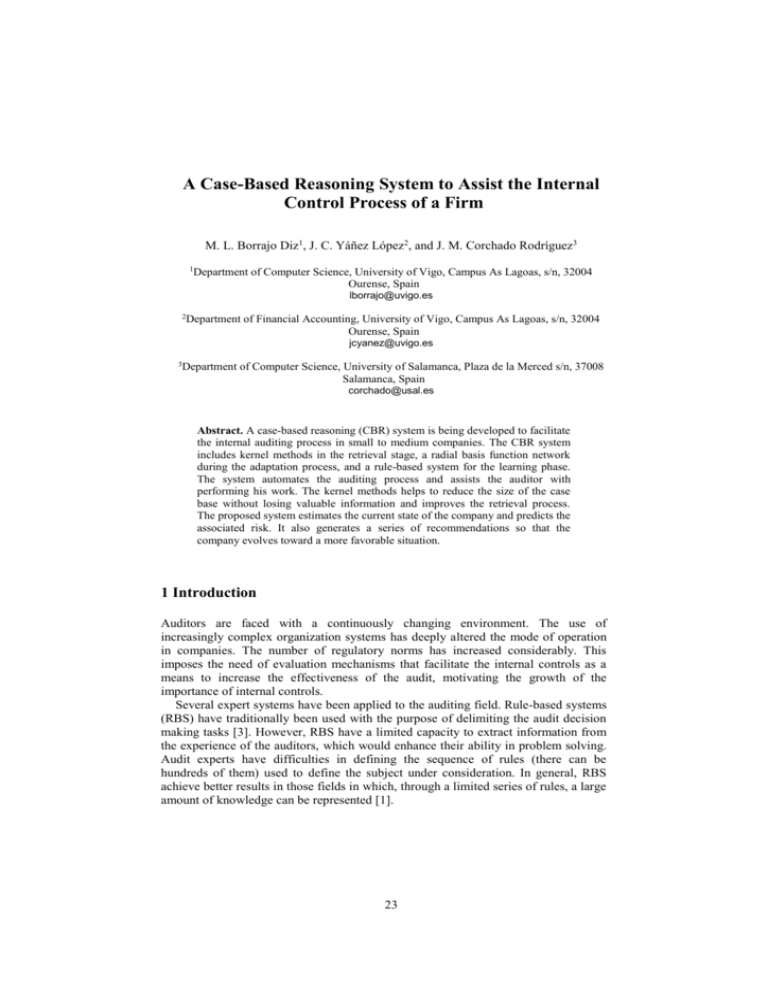
A Case-Based Reasoning System to Assist the Internal Control Process of a Firm M. L. Borrajo Diz1, J. C. Yáñez López2, and J. M. Corchado Rodríguez3 1Department of Computer Science, University of Vigo, Campus As Lagoas, s/n, 32004 Ourense, Spain lborrajo@uvigo.es 2Department of Financial Accounting, University of Vigo, Campus As Lagoas, s/n, 32004 Ourense, Spain jcyanez@uvigo.es 3Department of Computer Science, University of Salamanca, Plaza de la Merced s/n, 37008 Salamanca, Spain corchado@usal.es Abstract. A case-based reasoning (CBR) system is being developed to facilitate the internal auditing process in small to medium companies. The CBR system includes kernel methods in the retrieval stage, a radial basis function network during the adaptation process, and a rule-based system for the learning phase. The system automates the auditing process and assists the auditor with performing his work. The kernel methods helps to reduce the size of the case base without losing valuable information and improves the retrieval process. The proposed system estimates the current state of the company and predicts the associated risk. It also generates a series of recommendations so that the company evolves toward a more favorable situation. 1 Introduction Auditors are faced with a continuously changing environment. The use of increasingly complex organization systems has deeply altered the mode of operation in companies. The number of regulatory norms has increased considerably. This imposes the need of evaluation mechanisms that facilitate the internal controls as a means to increase the effectiveness of the audit, motivating the growth of the importance of internal controls. Several expert systems have been applied to the auditing field. Rule-based systems (RBS) have traditionally been used with the purpose of delimiting the audit decision making tasks [3]. However, RBS have a limited capacity to extract information from the experience of the auditors, which would enhance their ability in problem solving. Audit experts have difficulties in defining the sequence of rules (there can be hundreds of them) used to define the subject under consideration. In general, RBS achieve better results in those fields in which, through a limited series of rules, a large amount of knowledge can be represented [1]. 23 To try to overcome these problems we are developing a CBR system [2,4] for assisting in the internal control process of small to medium enterprises (SME). Here we outline the basic characteristics that describe the proposed system, which is also capable of detecting the weaknesses in a company’s workflow. The system helps auditors to take decisions based on the risk associated with the current state of the company, and in generating recommendations. 2 The Proposed CBR System The structure of the developed system is based on CBR. In the retrieve phase, it uses a variant of a kernel method as a mechanism for selecting similar cases to the given problem. A RBF (Radial Basis Function) neural network is used during the reuse phase to facilitate the adaptation of the cases previously retrieved to the context of the new problem. During the retain phase the success probability associated with each case is modified, taking into consideration information about system performance. Fig. 1. CBR system control flow The processes carried out inside a company are included in functional areas [5]. Each one of these areas is considered a function. This way, the functions that are 24 usually carried out in a company are: Purchases, Treasury, Sales, Information Technology, Immobilized, Legal Normative Execution, and Personal Politics. Each function can be broken down into a collection of activities. For example, the function Information Technology is divided into the following activities: Computer plan development, Study of systems, Installation of Systems, Treatment of the information flows and Security management. In the same way, each of the activities includes a wide range of concrete tasks (register, authorize, approve, harmonize, separate obligations, operate, etc.). A case represents specific knowledge about a particular situation of the firm. A case is created to represent the “shape” of each one of the activities developed in the company. As each activity is composed of several tasks, it is necessary that these tasks have been carried out correctly so that the activity is developed appropriately. Table 1 shows the attributes of a case. Table 1. Case attributes IDENTIFICATION DESCRIPTION Case number Unique identification: positive integer number. Input vector Information about the tasks (n sub-vectors) that compose an industrial activity: ((t1,GI1,V1),(t2,GI2,V2),...,(Tn,GIn,Vn)) for n tasks. Output vector Function number Activity number Reliability Each task sub-vector has the following structure: (Ti,GIi,Vi) Ti: Task unique identification number. GIi: importance for this task inside the activity. Can only take one of the following values: VI (Very important). I (Important). NVI (Not very important). Vi: Value of the realization state of a given task. Positive integer number (between 1 and 10). Vector with two parameters: The activity state and the associated risk level. The field “activity state” takes three values: Insufficient: if the activity is being carried out poorly. Nominal Satisfactory: if the activity is being carried out perfectly. The field “risk level” can take three values: High Nominal Low Unique Identification number for each function. Unique Identification number for each activity. Percentage of probability of success. 25 The auditing method is divided into two processes. Process A helps to determine the state of each activity and its associated level of risk and Process B generates the recommendations to improve a given activity. These Processes are now outlined. Process A involves the following steps: (a1) Retrieve the most similar cases to the problem case using kernel methods. (a2) Reuse the case(s) to attempt to solve the problem, using a RBF neural network. (a3) Revise the proposed solution. A human expert carries out this step. (a4) Retain the new solution as a part of a new case Process B is divided into the following stages: (b1) In this step, the case base is searched to find the most similar cases to the problem case. The cases with higher value in the “activity state” (in output vector) and "reliability" are selected. These retrieved cases are then used to generate the recommendations. (b2) Reuse the retrieved case(s). A human expert carries out this stage. The evolution of the company during the last year is analysed. (b3) Generation of recommendations. A rule-based system is used to identify the tasks that should be improved and therefore modified. The differences between the input vector of the problem case and the input vector of the retrieved case are used to generate such recommendations. (b4) Retain. Cases are modified depending on the system success. Once the company has applied the generated recommendations, the company is evaluated. If the company has evolved positively, the reliability attribute of the cases is increased. Otherwise, the reliability is decreased. We are now on the process of implementing the system. Once we have implemented the basic infrastructure, different techniques will be tested and evaluated for the retrieval, reuse, revision, and adaptation stages. Data is now being collected and although several partial experiments have been carried out, the previously outlined project is just starting. References 1. Chandrasekaran, B.: Expert systems: matching techniques to tasks. In Reitman, W. (ed.), Artificial Intelligence Applications for Business, Ablex, Norwood, NJ, (1984) 41-85 2. Corchado J. M. and Lees B.: Adaptation of Cases for Case-based Forecasting with Neural Network Support. In: S.K Pal, T.S. Dillon and D.S. Yeung (Eds.), Soft Computing in Case Based Reasoning, Springer Verlag, London (2000) 3. Denna, E.L., Hansen, J.V. and Meservy, R.: Development and application of expert systems in audit services. Transactions on Knowledge and Data Engineering (1991) 4. Fyfe, C. and Corchado, J. M. Automating the construction of CBR systems using Kernel Methods. Computing and Information Systems Journal. Vol. 7, No. 7, pp. 29-43, (2001) ISBN: 1352-9404 5. Yañez, J.C., Borrajo, L., Corchado, J.M.. A Case-based Reasoning System for Business Internal Control. Fourth International ICSC Symposium on Soft Computing and Intelligent Systems for Industry. Scotland (U.K.) (2001) 26
